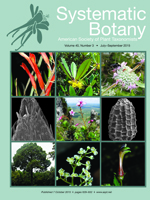Genetic concepts within the Bromelioideae are highly problematic, in particular within the tank-forming “core bromelioid” clade. Previous molecular studies showed that the largest genus, Aechmea, and allied genera are polyphyletic and require revision. Here we focus on one group within the Aechmea alliance, the Portea/Gravisia group. To assess whether species of this group form a distinct lineage within the core bromelioid clade, and to clarify generic limits and interspecific relationships within the group, we generated and analyzed amplified fragment length polymorphisms (AFLP). In total, 69 species were sampled, including 26 species previously assigned to the Portea/Gravisia group. Neighbor joining, maximum likelihood and Bayesian analyses of the AFLP data consistently retrieved the Portea/Gravisia group as a monophyletic clade with several subclades, comprising species from the genera Aechmea, Canistrum and Portea. The phylogenetic distribution of polyporate pollen of the resulting trees indicates this character state arose once within the core bromelioids and thus can be regarded as a synapomorphy for the Portea/Gravisia clade. Further, our study shows that within the Portea/Gravisia group, subclades are characterized by petal color and geographic distribution. Thus, the present study is a further advance in the challenging task of elucidating phylogenetic relationships within the core bromelioids as the basis for a revised taxonomy of this ecologically important group.
How to translate text using browser tools
22 September 2015
Elucidating Phylogenetic Relationships in the Aechmea Alliance: AFLP Analysis of Portea and the Gravisia Complex (Bromeliaceae, Bromelioideae)
Sascha Heller,
Elton M. C. Leme,
Katharina Schulte,
Ana M. Benko-Iseppon,
Georg Zizka
ACCESS THE FULL ARTICLE

Systematic Botany
Vol. 40 • No. 3
September 2015
Vol. 40 • No. 3
September 2015
Brazil
Canistrum
Nidularioids
phylogeny
pollen




